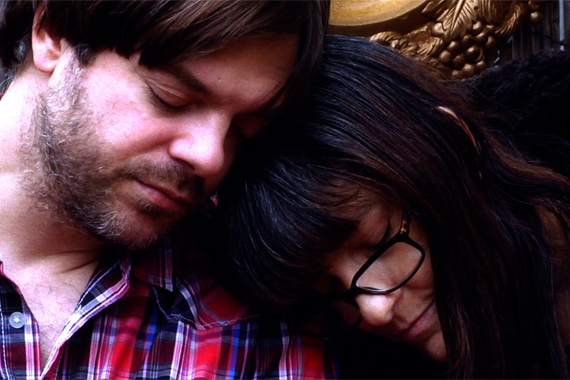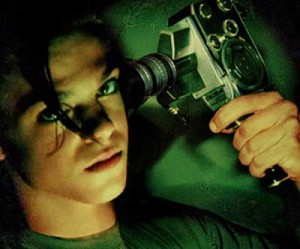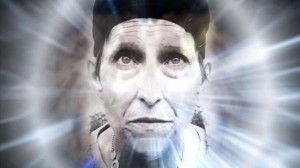Image may be NSFW.
Clik here to view.
“It’s 2004,” filmmaker Jonathan Caouette told me several years back, “and I think we’re ready for some really crazy stuff now.”
Caouette was speaking about his boundary-breaking family portrait Tarnation, a revelatory work of D.I.Y. filmmaking that shook up the independent film world—thanks not just to its iMovie-made ingenuity (it famously cost just $218.32 to make) but also for its psychotronic storytelling style. An MTV Real World episode mashed together with the stroboscopic light-shows of avant-gardist Ken Jacobs, the film flash-edits hundreds of family photographs together with scenes from ’70s horror flicks as well as home movies of Caouette, as a kid, enacting and experiencing terrible moments of abuse and angst. As J. Hoberman wrote in his Village Voice review at the time, “Jonathan Caouette’s precocious memoir-cum-psychodrama … is so raw that it bleeds.”
If the personal documentary form had for years been associated with the wry personal commentaries of anxiety-ridden self-analysts Ross McElwee (Sherman’s March) and Alan Berliner (Nobody’s Business), Caouette had blown the whole thing up in an explosive purge: Documentary filmmakers, welcome to the digital age!
Image may be NSFW.
Clik here to view. While YouTube, launched a year later, would engender millions of far less talented Caouettes, Tarnation didn’t exactly catch fire within the art-house industry. The movie earned more than a million dollars in box office receipts worldwide—a not-too-shabby figure for a weird personal doc—but as a phenomenon, Tarnation seems to be regarded today a kind of outsider-art oddball, which is pretty much how it was received when it premiered at the 2004 Sundance Film Festival in its fringe, avant-garde sidebar, New Frontier.
While YouTube, launched a year later, would engender millions of far less talented Caouettes, Tarnation didn’t exactly catch fire within the art-house industry. The movie earned more than a million dollars in box office receipts worldwide—a not-too-shabby figure for a weird personal doc—but as a phenomenon, Tarnation seems to be regarded today a kind of outsider-art oddball, which is pretty much how it was received when it premiered at the 2004 Sundance Film Festival in its fringe, avant-garde sidebar, New Frontier.
Eight years later, you might think Caouette’s bravura experimental montages and eye-popping digital manipulations would have penetrated the language of nonfiction filmmaking to a greater extent. But not so. In the intervening years, there’s been nothing quite like it.
Except, of course, Caouette’s equally psychedelic follow-up Walk Away Renee, which premiered at the Cannes Film Festival in 2011 and, perhaps indicative of the industry’s apathy towards Caouette’s idiosyncratic filmmaking, hasn’t played at a single U.S. festival until this week, when it screens at Brooklyn’s BAMcinemaFest. (It is also launching simultaneously online today through this website’s own Doc Club distribution program.)
While Walk Away Renee regretfully treads over much of the same terrain as Tarnation, examining Caouette’s relationship with his mentally ill mother, Renee Leblanc, and senile grandparents—and hence has little of his debut film’s sense of startling discovery—the movie shows Caouette’s commitment to pushing the aesthetics of the personal documentary forward. In one late sequence, the film takes off into a cosmic flight of fancy reminiscent of Terrence Malick’s Tree of Life. Indulgent? Maybe, but Caouette has never been one for subtlety. His is a world of histrionics and psychosis. And if Tarnation‘s main mode of visual “shock therapy”—as Hoberman aptly defined it—involves the flicker effect of rapid-fire digital editing, Walk Away Renee is more languorous and hallucinatory.
While the new film employs some of Tarnation‘s trademark text narration and overflowing photo-montages, Caouette seems less interested here in using film to recreate a dissociative breakdown than in having it visually convey his mother’s schizoaffective disorder and her Lithium-medicated hallucinatory haze. During a cross-country drive from an assisted living center in Texas to his apartment in New York, the frazzled filmmaker and his bipolar mom, Renee—who has recently lost her meds—stop at a carnival for a dreamy multiple-exposure head-trip. Another surreal sequence, in which his singing mother, elderly grandfather and a cackling baby doll are trapped together in a small white room, recalls early David Lynch.
Walk Away Renee is filled with Image may be NSFW.
Clik here to view. plenty of indelible images: his mother’s face surrounded by an outburst of cosmic light; her turning in profile ever so slightly away from the camera in dreamy slow-motion; Caouette’s head bobbing atop the surface of a bubbly bath as if disconnected from his body. But the film isn’t all so impressionistic. There are plenty of straightforward scenes following their strange quotidian lives, driving in a U-Haul truck or hanging out in his apartment. These sequences recall some of the later sequences in Tarnation when Renee is seen living with Jonathan in New York. They’re less reliant on technical tricks or visual overstimulation, and exemplify Caouette’s filmmaking at its most discomfiting. He lets us see Renee in the unvarnished real-time of verité filmmaking: repeatedly dancing, laughing maniacally or pretending to be Dolly Parton—in short, seriously mentally ill.
plenty of indelible images: his mother’s face surrounded by an outburst of cosmic light; her turning in profile ever so slightly away from the camera in dreamy slow-motion; Caouette’s head bobbing atop the surface of a bubbly bath as if disconnected from his body. But the film isn’t all so impressionistic. There are plenty of straightforward scenes following their strange quotidian lives, driving in a U-Haul truck or hanging out in his apartment. These sequences recall some of the later sequences in Tarnation when Renee is seen living with Jonathan in New York. They’re less reliant on technical tricks or visual overstimulation, and exemplify Caouette’s filmmaking at its most discomfiting. He lets us see Renee in the unvarnished real-time of verité filmmaking: repeatedly dancing, laughing maniacally or pretending to be Dolly Parton—in short, seriously mentally ill.
How are we to process scenes like these, and how are we to square ourselves as spectators? Let’s turn to Ross McElwee, one of the founding fathers of subjective personal filmmaking, and his contemporary Ed Pincus, whose seminal 1970s work Diaries examines the thorny terrain of his open marriage at that time. In an essay recently published at the Harvard Film Archives website, McElwee likens his experience of watching Diaries to “not a sense of voyeurism but of privileged intimacy.” One scene, in particular, in which Pincus invades his wife’s privacy “make[s] us squirm,” he writes. “We feel alienated from the filmmaker, who seems merciless in his determination to keep filming…. In the long run, we become bonded to Ed and his vision, partially because of his willingness to show his dark side.”
Likewise, Tarnation and Walk Away Renee show some rather unpleasant sides of the director and his mother. Indeed, the films can be off-putting, which may be one of the reasons why few filmmakers have followed in Caouette’s brash footsteps. For all of its digital razzle-dazzle, the work is ultimately about mental combustion and collapse, which in turn drives his unique aesthetic choices. How many filmmakers can claim to be so closely in tune with mental illness to cinematically reproduce it? And for those filmmakers who are not, perhaps there are other areas of the human experience they might consider exploring with a similar audacity.
Anthony Kaufman has written about films and the film industry for The New York Times, The Los Angeles Times, The Chicago Tribune, The Village Voice, and Slate. He is currently a regular contributor to Variety, The Wall Street Journal Online, Filmmaker Magazine, The Utne Reader, and writes the ReelPolitik blog for Indiewire.com.